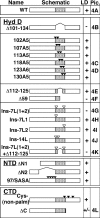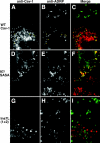Role of the hydrophobic domain in targeting caveolin-1 to lipid droplets
- PMID: 14709541
- PMCID: PMC2171963
- DOI: 10.1083/jcb.200303037
Role of the hydrophobic domain in targeting caveolin-1 to lipid droplets
Abstract
Although caveolins normally reside in caveolae, they can accumulate on the surface of cytoplasmic lipid droplets (LDs). Here, we first provided support for our model that overaccumulation of caveolins in the endoplasmic reticulum (ER) diverts the proteins to nascent LDs budding from the ER. Next, we found that a mutant H-Ras, present on the cytoplasmic surface of the ER but lacking a hydrophobic peptide domain, did not accumulate on LDs. We used the fact that wild-type caveolin-1 accumulates in LDs after brefeldin A treatment or when linked to an ER retrieval motif to search for mutants defective in LD targeting. The hydrophobic domain, but no specific sequence therein, was required for LD targeting of caveolin-1. Certain Leu insertions blocked LD targeting, independently of hydrophobic domain length, but dependent on their position in the domain. We propose that proper packing of putative hydrophobic helices may be required for LD targeting of caveolin-1.
Figures









Similar articles
-
Accumulation of caveolin in the endoplasmic reticulum redirects the protein to lipid storage droplets.J Cell Biol. 2001 Mar 5;152(5):1071-8. doi: 10.1083/jcb.152.5.1071. J Cell Biol. 2001. PMID: 11238461 Free PMC article.
-
A caveolin dominant negative mutant associates with lipid bodies and induces intracellular cholesterol imbalance.J Cell Biol. 2001 Mar 5;152(5):1057-70. doi: 10.1083/jcb.152.5.1057. J Cell Biol. 2001. PMID: 11238460 Free PMC article.
-
Caveolin-2 is targeted to lipid droplets, a new "membrane domain" in the cell.J Cell Biol. 2001 Mar 5;152(5):1079-85. doi: 10.1083/jcb.152.5.1079. J Cell Biol. 2001. PMID: 11238462 Free PMC article.
-
Caveolins, caveolae, and lipid rafts in cellular transport, signaling, and disease.Biochem Cell Biol. 2004 Feb;82(1):129-44. doi: 10.1139/o03-071. Biochem Cell Biol. 2004. PMID: 15052333 Review.
-
Formation of transmembrane helices in vivo--is hydrophobicity all that matters?J Gen Physiol. 2007 May;129(5):353-6. doi: 10.1085/jgp.200709740. Epub 2007 Apr 16. J Gen Physiol. 2007. PMID: 17438115 Free PMC article. Review. No abstract available.
Cited by
-
Murine diacylglycerol acyltransferase-2 (DGAT2) can catalyze triacylglycerol synthesis and promote lipid droplet formation independent of its localization to the endoplasmic reticulum.J Biol Chem. 2011 Aug 12;286(32):28235-46. doi: 10.1074/jbc.M111.256008. Epub 2011 Jun 16. J Biol Chem. 2011. PMID: 21680734 Free PMC article.
-
Delayed recruiting of TPD52 to lipid droplets - evidence for a "second wave" of lipid droplet-associated proteins that respond to altered lipid storage induced by Brefeldin A treatment.Sci Rep. 2019 Jul 5;9(1):9790. doi: 10.1038/s41598-019-46156-1. Sci Rep. 2019. PMID: 31278300 Free PMC article.
-
Lipid Droplet, a Key Player in Host-Parasite Interactions.Front Immunol. 2018 May 23;9:1022. doi: 10.3389/fimmu.2018.01022. eCollection 2018. Front Immunol. 2018. PMID: 29875768 Free PMC article. Review.
-
Refurbishing the plasmodesmal chamber: a role for lipid bodies?Front Plant Sci. 2014 Feb 24;5:40. doi: 10.3389/fpls.2014.00040. eCollection 2014. Front Plant Sci. 2014. PMID: 24605115 Free PMC article.
-
The Evolving Role of Caveolin-1: A Critical Regulator of Extracellular Vesicles.Med Sci (Basel). 2020 Nov 4;8(4):46. doi: 10.3390/medsci8040046. Med Sci (Basel). 2020. PMID: 33158117 Free PMC article. Review.
References
-
- Abell, B.M., S. High, and M.M. Moloney. 2002. Membrane topology of oleosin is constrained by its long hydrophobic domain. J. Biol. Chem. 277:8602–8610. - PubMed
-
- Arbuzova, A., L. Wang, J. Wang, G. Hangyas-Mihalyne, D. Murray, B. Honig, and S. McLaughlin. 2000. Membrane binding of peptides containing both basic and aromatic residues. Experimental studies with peptides corresponding to the scaffolding region of caveolin and the effector region of MARCKS. Biochemistry. 39:10330–10339. - PubMed
-
- Arreaza, G., and D.A. Brown. 1995. Sorting and intracellular trafficking of a glycosylphosphatidylinositol-anchored protein and two hybrid proteins with the same ectodomain in MDCK kidney epithelial cells. J. Biol. Chem. 270:23641–23647. - PubMed
-
- Barba, G., F. Harper, T. Harada, M. Kohara, S. Goulinet, Y. Matsuura, G. Eder, Z. Schaf, M.J. Chapman, T. Miyamura, and C. Brechot. 1997. Hepatitis C virus core protein shows a cytoplasmic localization and associates to cellular lipid storage droplets. Proc. Natl. Acad. Sci. USA. 94:1200–1205. - PMC - PubMed
Publication types
MeSH terms
Substances
Grants and funding
LinkOut - more resources
Full Text Sources
Other Literature Sources
Research Materials
Miscellaneous

